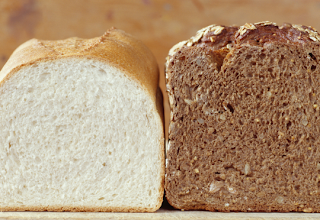First Things First: What is Fiber?
Fiber
is a kind of carbohydrate that the human body cannot digest or absorb. There
are two types of fiber: insoluble fiber and soluble fiber, both of which are
only found in plant foods. Each type of fiber has different benefits in the
body, so both insoluble and soluble fiber should be included in a healthy diet.
®
Insoluble
Fiber: does not dissolve in water
o Function:
Promotes movement through the digestive tract and increases stool bulk, which
can benefit those who struggle with constipation or irregularity.
o
Good
Sources: Whole grains, bran, nuts, and most
vegetables
®
Soluble
Fiber: does dissolve in water
o
Function:
Can help lower blood cholesterol levels as well as lower blood sugar levels.
o
Good
Sources: Oats, peas, beans, apples, citrus
fruits, carrots, barley, and psyllium
Benefits of a High
Fiber Diet
Research
has shown a variety of benefits from a diet high in fiber. Want in on the
following list? Gradually increase the amount of fiber-rich foods in your diet,
and include plenty of water every day.
®
Normalizes
bowel movements. Fiber increases the size and
weight of stool, improving regularity and ease of bowel movements
® Helps
maintain bowel integrity and health. A high-fiber
diet is associated with a reduced risk of hemorrhoids and diverticular disease.
Research suggests it may also decrease risk of colorectal cancer.
 ® Lowers
blood cholesterol levels. Soluble fiber can help
decrease total blood cholesterol levels by decreasing LDL (“bad”) cholesterol.
Studies also show that high fiber diets can reduce blood pressure and
inflammation, which can improve heart health.
® Lowers
blood cholesterol levels. Soluble fiber can help
decrease total blood cholesterol levels by decreasing LDL (“bad”) cholesterol.
Studies also show that high fiber diets can reduce blood pressure and
inflammation, which can improve heart health.
® Helps
control blood sugar levels. Fiber, especially
soluble fiber, can slow the absorption of sugar, which can help improve blood
sugar for people with diabetes or people with hypoglycemia. A diet high in
insoluble fiber has been associated with a decreased risk for developing Type 2
diabetes.
® Aids
in weight loss. Fiber adds bulk to meals,
increasing the time required to consume the meal, which decreases the risk of
overeating. High fiber meals also increase and prolong the feeling of fullness,
which means you’re less likely to feel hungry in between scheduled meals and
snacks.
How to Increase Fiber
Intake:
Yes,
fiber supplements like Metamucil and Benefiber are high in fiber, but don’t
provide all the benefits associated with natural sources of fiber found in whole
foods. Instead of relying on supplements, increase your intake of plant foods
that are naturally rich in fiber. These foods also offer other nutritional
benefits, such as vitamins, minerals, and phytonutrients like antioxidants. To
receive the greatest health benefit, eat a wide variety of high-fiber foods,
since the type and amount of fiber varies in plant foods.
Here
are a few easy ways to increase the fiber in your diet:
® Eat
more whole grains. Look for the word “whole” as the
first ingredient in the ingredient list, and avoid white, enriched, or refined
grains.
® Eat
more fruits and vegetables. Produce with the
skin intact are typically higher in fiber. And juice doesn't count!
® Eat
more beans and legumes, like chickpeas,
black beans, kidney beans, edamame, and peas.
® Eat
more nuts and seeds, like almonds,
sunflower seeds, walnuts, pumpkin seeds, and pistachios.
® Remember to increase the amount of fiber in your diet
slowly, and include plenty of water
every day; a sudden increase of fiber in the diet without adequate hydration can
create some gastrointestinal discomfort.
Remember, a diet overhaul
doesn't come around overnight; instead, focus on forming new habits over several weeks
until it becomes your “new normal.” For example, try including a salad with dinner most
nights of the week, or using fruit as a snack instead of chips. Then find some new
recipes that feature beans - winter is a great time to experiment with your
favorite chili recipe, after all. Each month, incorporate a new whole grain
into your home; brown rice, whole grain bread, quinoa, whole grain pasta, and
oats are all great whole grains that will increase the fiber in your diet as
well as improve your overall nutrition. Start carrying a water bottle with you
and keep track of how many times you refill it each day.
By making progress the main
attraction, goal setting stops being a black and white “Success or Failure” but
instead a gradual self-improvement project. Keep working on improving your
habits, and good health will follow.
Thanks for reading!
Anna


